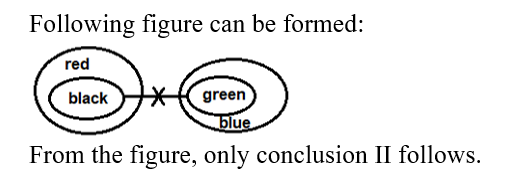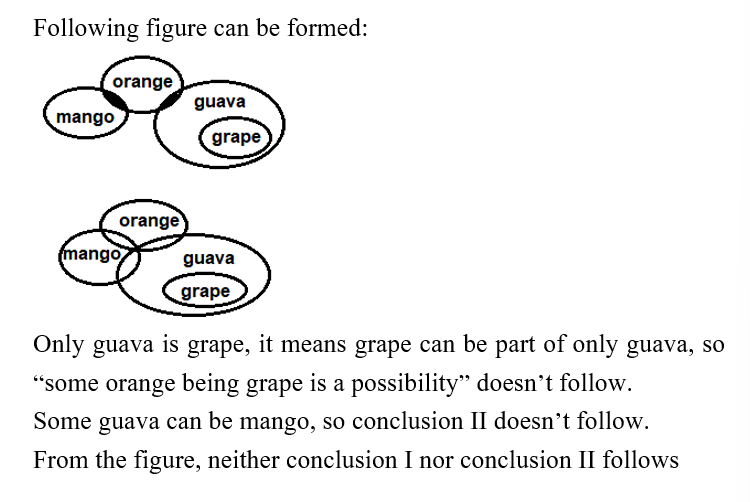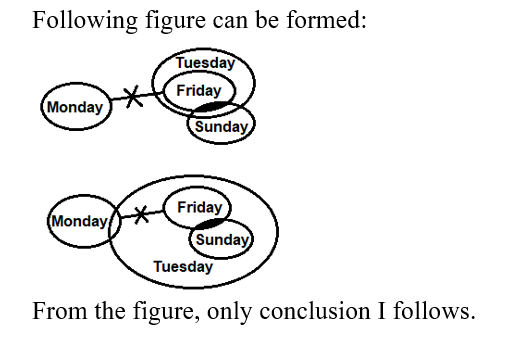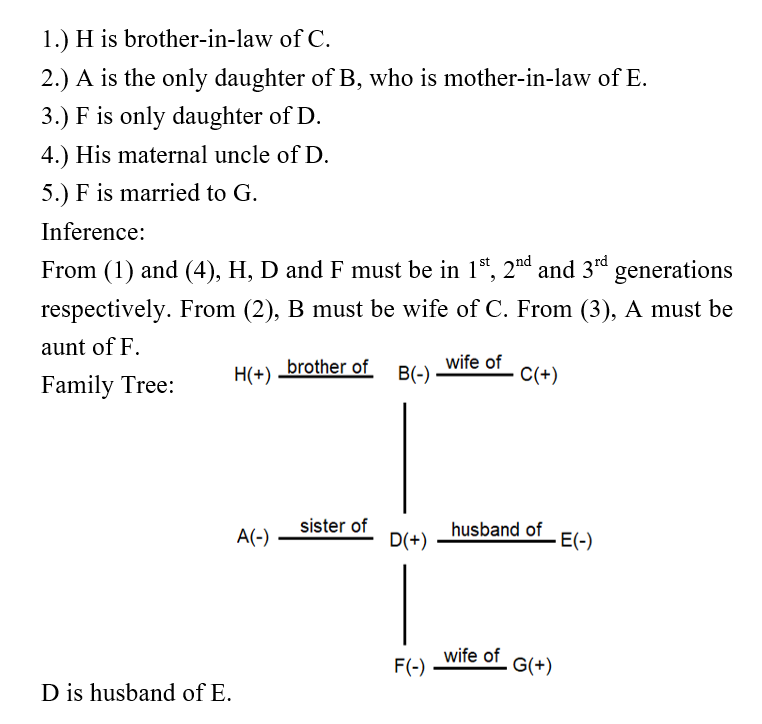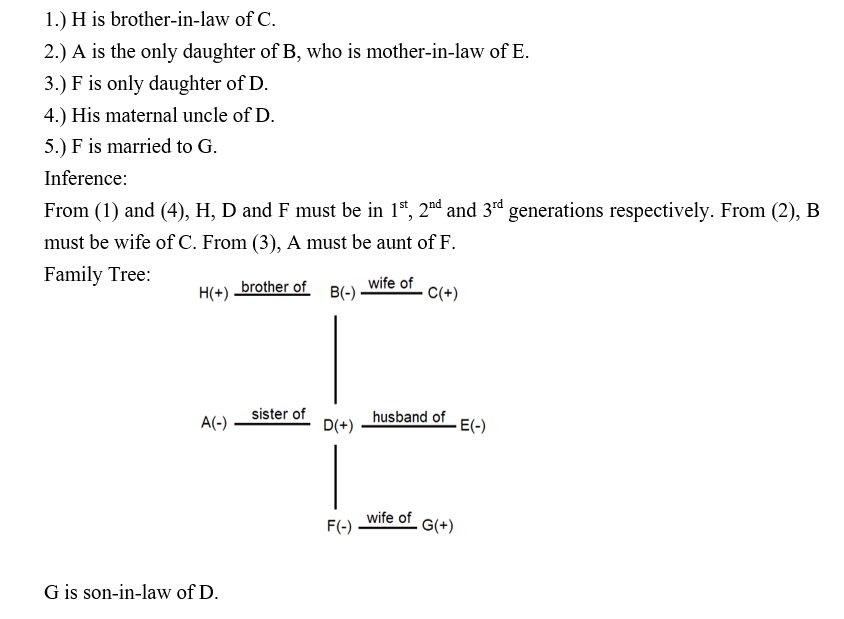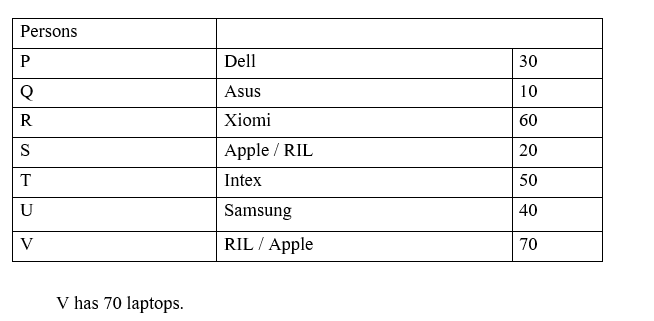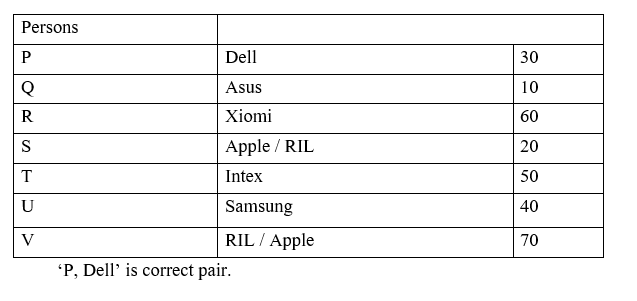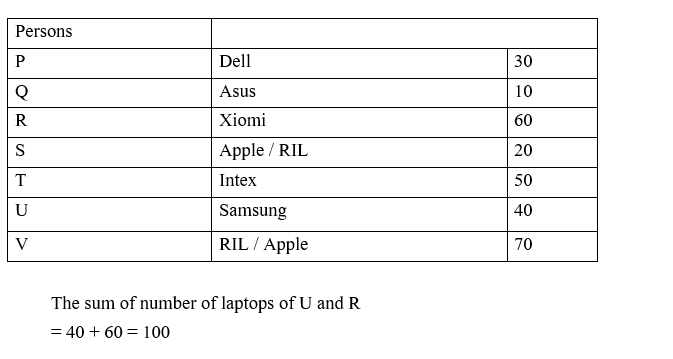Question 1:
Direction: In the question below there are three statements followed by two conclusions I and II. You have to take the three given statements to be true even if they seem to be at variance from commonly known facts and then decide which of the given conclusions logically follows from the three statements disregarding commonly known facts.
निर्देश: प्रश्न में, तीन कथन और उसके बाद दो निष्कर्ष I और II दिए गए हैं। आपको दिए गए तीन कथनों को सत्य मानना है, भले ही वे सामान्य रूप से ज्ञात तथ्यों से भिन्न दिखाई देते हों और फिर तय करें कि दिए गए निष्कर्षों में से कौन-सा निष्कर्ष सामान्य रूप से ज्ञात तथ्यों की अवहेलना करते हुए तीन कथनों का तार्किक रूप से अनुसरण करता है।
Statements:
कथन: कोई काला हरा नहीं है / No black is green
सभी हरा नीला है / All green is blue
प्रत्येक काला लाल है / Every black is red
Conclusions:
I. कुछ लाल नीला है / Some red is blue
II. कुछ नीला काला नहीं है / Some blue is not black
(A) Neither conclusion I nor conclusion II follows
(A) न तो निष्कर्ष I और न ही निष्कर्ष II अनुसरण करता है
(B) Only conclusion I follows
(B) केवल निष्कर्ष I अनुसरण करता है
(C) Only conclusion II follows
(C) केवल निष्कर्ष II अनुसरण करता है
(D) Both conclusion I and conclusion II follow.
(D) निष्कर्ष I और निष्कर्ष II दोनों अनुसरण करते हैं।
(E) None of the above
(E) उपर्युक्त कोई नहीं
Question 2:
Direction: In the question below there are three statements followed by two conclusions I and II. You have to take the three given statements to be true even if they seem to be at variance from commonly known facts and then decide which of the given conclusions logically follows from the three statements disregarding commonly known facts.
निर्देश: प्रश्न में, तीन कथन और उसके बाद दो निष्कर्ष I और II दिए गए हैं। आपको दिए गए तीन कथनों को सत्य मानना है, भले ही वे सामान्य रूप से ज्ञात तथ्यों से भिन्न दिखाई देते हों और फिर तय करें कि दिए गए निष्कर्षों में से कौन-सा निष्कर्ष सामान्य रूप से ज्ञात तथ्यों की अवहेलना करते हुए तीन कथनों का तार्किक रूप से अनुसरण करता है।
Statements: Only a few mango is orange
कथन: केवल कुछ आम संतरा है
Only few orange is guava
केवल कुछ संतरा अमरुद है
Only guava is grape
केवल अमरुद अंगूर है
Conclusions: I. Some orange being grape is a possibility
निष्कर्ष: I. कुछ संतरा के अंगूर होने की संभावना है
II. No guava is mango
II. कोई अमरुद आम नहीं है
(A) Only conclusion II follows
(A) केवल निष्कर्ष II अनुसरण करता है
(B) Only conclusion I follows
(B) केवल निष्कर्ष I अनुसरण करता है
(C) Neither conclusion I nor conclusion II follows
(C) न तो निष्कर्ष I और न ही निष्कर्ष II अनुसरण करता है
(D) Both conclusion I and conclusion II follow.
(D) निष्कर्ष I और निष्कर्ष II दोनों अनुसरण करते हैं।
(E) None of the above
(E) उपर्युक्त कोई नहीं
Question 3:
Direction: In the question below there are three statements followed by two conclusions I and II. You have to take the three given statements to be true even if they seem to be at variance from commonly known facts and then decide which of the given conclusions logically follows from the three statements disregarding commonly known facts.
निर्देश: प्रश्न में, तीन कथन और उसके बाद दो निष्कर्ष I और II दिए गए हैं। आपको दिए गए तीन कथनों को सत्य मानना है, भले ही वे सामान्य रूप से ज्ञात तथ्यों से भिन्न दिखाई देते हों और फिर तय करें कि दिए गए निष्कर्षों में से कौन-सा निष्कर्ष सामान्य रूप से ज्ञात तथ्यों की अवहेलना करते हुए तीन कथनों का तार्किक रूप से अनुसरण करता है।
Statements: No Monday is Friday
कथन: कोई सोमवार शुक्रवार नहीं है
All Friday is Tuesday
सभी शुक्रवार मंगलवार है
Only a few Sunday is Friday
केवल कुछ रविवार शुक्रवार हैं
Conclusions: I. Some Tuesday being Monday is a possibility
निष्कर्ष: I. कुछ मंगलवार के सोमवार होने की संभावना है
II. All Sunday is Tuesday
II. सभी रविवार मंगलवार है
(A) Neither conclusion I nor conclusion II follows
(A) न तो निष्कर्ष I और न ही निष्कर्ष II अनुसरण करता है
(B) Only conclusion I follows
(B) केवल निष्कर्ष I अनुसरण करता है
(C) Only conclusion II follows
(C) केवल निष्कर्ष II अनुसरण करता है
(D) Both conclusion I and conclusion II follow.
(D) निष्कर्ष I और निष्कर्ष II दोनों अनुसरण करते हैं।
(E) None of the above
(E) उपर्युक्त कोई नहीं
Question 4:
Directions: Answer the questions based on the information given below.
निर्देश: दिए गए जानकारी के आधार पर सवालों के उत्तर दें।
There are eight members A, B, C, D, E, F, G and H in the family of three generations. No single person has a child. His brother-in-law of C. A is the only daughter of B, who is mother-in-law of E. F is only daughter of D. His maternal uncle of D. F is married to G.
तीन पीढ़ी के एक परिवार में आठ सदस्य A, B, C, D, E, F, G और H है। किसी एकल अभिवावक का कोई बच्चा नहीं है। H C का साला/जीजा/देवर है। A B की इकलौती पुत्री है और B E की सास है। F D की इकलौती पुत्री है। H D का मामा है। F G से विवाहित है।
Who among the following is husband of E?
निम्नलिखित में से कौन E का पति है?
Question 5:
Directions: Answer the questions based on the information given below.
निर्देश: दिए गए जानकारी के आधार पर सवालों के उत्तर दें।
There are eight members A, B, C, D, E, F, G and H in the family of three generations. No single person has a child. His brother-in-law of C. A is the only daughter of B, who is mother-in-law of E. F is only daughter of D. His maternal uncle of D. F is married to G.
तीन पीढ़ी के एक परिवार में आठ सदस्य A, B, C, D, E, F, G और H है। किसी एकल अभिवावक का कोई बच्चा नहीं है। H C का साला/जीजा/देवर है। A B की इकलौती पुत्री है और B E की सास है। F D की इकलौती पुत्री है। H D का मामा है। F G से विवाहित है।
How is H related to A?
H A से कैसे सम्बंधित है?
Question 6:
Directions: Answer the questions based on the information given below.
निर्देश: दिए गए जानकारी के आधार पर सवालों के उत्तर दें।
There are eight members A, B, C, D, E, F, G and H in the family of three generations. No single person has a child. His brother-in-law of C. A is the only daughter of B, who is mother-in-law of E. F is only daughter of D. His maternal uncle of D. F is married to G.
तीन पीढ़ी के एक परिवार में आठ सदस्य A, B, C, D, E, F, G और H है। किसी एकल अभिवावक का कोई बच्चा नहीं है। H C का साला/जीजा/देवर है। A B की इकलौती पुत्री है और B E की सास है। F D की इकलौती पुत्री है। H D का मामा है। F G से विवाहित है।
How is G related to D?
G D से कैसे सम्बंधित है?
Question 7:
Direction: In the question, assuming the given statements to be true, find which of the conclusion (s) among given three conclusions is /are definitely true and then give your answer accordingly.
निर्देश: निम्नलिखित प्रश्न में, दिए गए कथनों को सत्य मानकर, यह तय करना है कि दिए गए तीन निष्कर्षों में से कौन सा निष्कर्ष निश्चित रूप से सत्य है और फिर उसी अनुसार अपना उत्तर दें।
Statements: P > S < V; S > N ≥ D; W < D
Conclusions: I. P > D II. W < S
III. P > V
(A) Only conclusion I is true
(A) केवल निष्कर्ष I सत्य है
(B) Only conclusions I and II are true
(B) केवल निष्कर्ष I और II सत्य है
(C) Only conclusion III is true
(C) केवल निष्कर्ष III सत्य है
(D) All conclusions I, II and III are false
(D) सभी निष्कर्ष I, II और III गलत है
(E) Only conclusions II and III are true
(E) केवल निष्कर्ष II और III सत्य है
Question 8:
Directions Answer the questions based on the information given below.
निर्देश: नीचे दी गई जानकारी के आधार पर प्रश्नों के उत्तर दें।
Seven persons P, Q, R, S, T, U and V have different number of laptops among 10, 20, 30, 40, 50, 60 and 70 but not necessarily in same order. Each of them has laptop of different brands among Asus, Apple, Dell, Intex, RIL, Samsung, Xiomi.
U has Samsung laptops.S has 20 laptops. The difference in number of laptops of P and V is 40.One person has 60 Xiomi laptops. Neither Q nor T has Xiomi laptops. V has more laptops than that of R. One person has 50 intex laptops. T has more laptops than U, who does not have only 10 laptops. There are 20 more Dell laptops than Asus laptops.
सात व्यक्तियों P, Q, R, S, T, U और V के पास 10, 20, 30, 40, 50, 60 और 70 में से अलग-अलग संख्या में लैपटॉप हैं, लेकिन जरूरी नहीं कि इसी क्रम में हों। उनमें से प्रत्येक के पास एसस, एप्पल, डेल, इंटेक्स, RIL, सैमसंग, जिओमी के बीच विभिन्न ब्रांड के लैपटॉप हैं।
U के पास सैमसंग लैपटॉप हैं। S के पास 20 लैपटॉप हैं। P और V के लैपटॉप की संख्या का अंतर 40 है। एक व्यक्ति के पास 60 जिओमी लैपटॉप हैं। न तो Q और न ही T के पास जिओमी लैपटॉप हैं। V के पास R से अधिक लैपटॉप हैं। एक व्यक्ति के पास 50 इंटेक्स लैपटॉप हैं। T के पास U से अधिक लैपटॉप हैं और U के पास केवल 10 लैपटॉप नहीं हैं। एसस लैपटॉप से डेल लैपटॉप 20 अधिक हैं।
V has _____ laptops.
V के पास _____ लैपटॉप हैं।
Question 9:
Directions Answer the questions based on the information given below.
निर्देश: नीचे दी गई जानकारी के आधार पर प्रश्नों के उत्तर दें।
Seven persons P, Q, R, S, T, U and V have different number of laptops among 10, 20, 30, 40, 50, 60 and 70 but not necessarily in same order. Each of them has laptop of different brands among Asus, Apple, Dell, Intex, RIL, Samsung, Xiomi.
U has Samsung laptops.S has 20 laptops. The difference in number of laptops of P and V is 40.One person has 60 Xiomi laptops. Neither Q nor T has Xiomi laptops. V has more laptops than that of R. One person has 50 intex laptops. T has more laptops than U, who does not have only 10 laptops. There are 20 more Dell laptops than Asus laptops.
सात व्यक्तियों P, Q, R, S, T, U और V के पास 10, 20, 30, 40, 50, 60 और 70 में से अलग-अलग संख्या में लैपटॉप हैं, लेकिन जरूरी नहीं कि इसी क्रम में हों। उनमें से प्रत्येक के पास एसस, एप्पल, डेल, इंटेक्स, RIL, सैमसंग, जिओमी के बीच विभिन्न ब्रांड के लैपटॉप हैं।
U के पास सैमसंग लैपटॉप हैं। S के पास 20 लैपटॉप हैं। P और V के लैपटॉप की संख्या का अंतर 40 है। एक व्यक्ति के पास 60 जिओमी लैपटॉप हैं। न तो Q और न ही T के पास जिओमी लैपटॉप हैं। V के पास R से अधिक लैपटॉप हैं। एक व्यक्ति के पास 50 इंटेक्स लैपटॉप हैं। T के पास U से अधिक लैपटॉप हैं और U के पास केवल 10 लैपटॉप नहीं हैं। एसस लैपटॉप से डेल लैपटॉप 20 अधिक हैं।
Which of the following pair is correct?
निम्नलिखित में से कौन-सा जोड़ा सही है?
Question 10:
Directions Answer the questions based on the information given below.
निर्देश: नीचे दी गई जानकारी के आधार पर प्रश्नों के उत्तर दें।
Seven persons P, Q, R, S, T, U and V have different number of laptops among 10, 20, 30, 40, 50, 60 and 70 but not necessarily in same order. Each of them has laptop of different brands among Asus, Apple, Dell, Intex, RIL, Samsung, Xiomi.
U has Samsung laptops.S has 20 laptops. The difference in number of laptops of P and V is 40.One person has 60 Xiomi laptops. Neither Q nor T has Xiomi laptops. V has more laptops than that of R. One person has 50 intex laptops. T has more laptops than U, who does not have only 10 laptops. There are 20 more Dell laptops than Asus laptops.
सात व्यक्तियों P, Q, R, S, T, U और V के पास 10, 20, 30, 40, 50, 60 और 70 में से अलग-अलग संख्या में लैपटॉप हैं, लेकिन जरूरी नहीं कि इसी क्रम में हों। उनमें से प्रत्येक के पास एसस, एप्पल, डेल, इंटेक्स, RIL, सैमसंग, जिओमी के बीच विभिन्न ब्रांड के लैपटॉप हैं।
U के पास सैमसंग लैपटॉप हैं। S के पास 20 लैपटॉप हैं। P और V के लैपटॉप की संख्या का अंतर 40 है। एक व्यक्ति के पास 60 जिओमी लैपटॉप हैं। न तो Q और न ही T के पास जिओमी लैपटॉप हैं। V के पास R से अधिक लैपटॉप हैं। एक व्यक्ति के पास 50 इंटेक्स लैपटॉप हैं। T के पास U से अधिक लैपटॉप हैं और U के पास केवल 10 लैपटॉप नहीं हैं। एसस लैपटॉप से डेल लैपटॉप 20 अधिक हैं।
What is the sum of number of laptops of U and R?
U और R के लैपटॉप की संख्या का योग क्या है?

